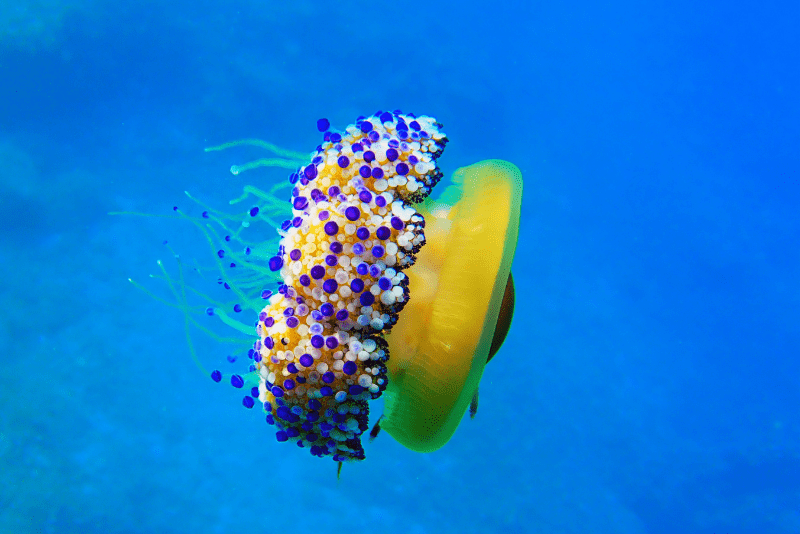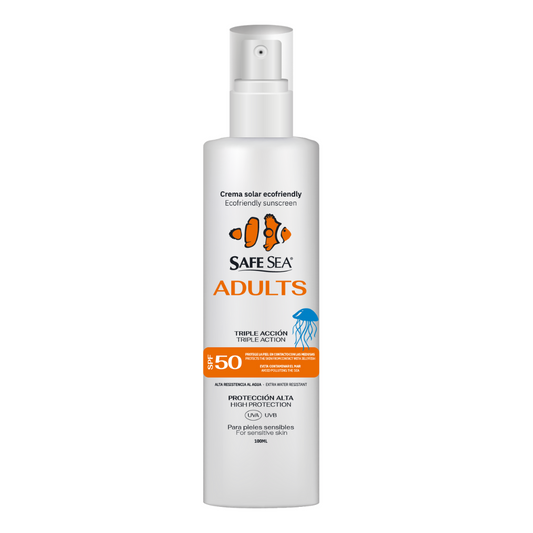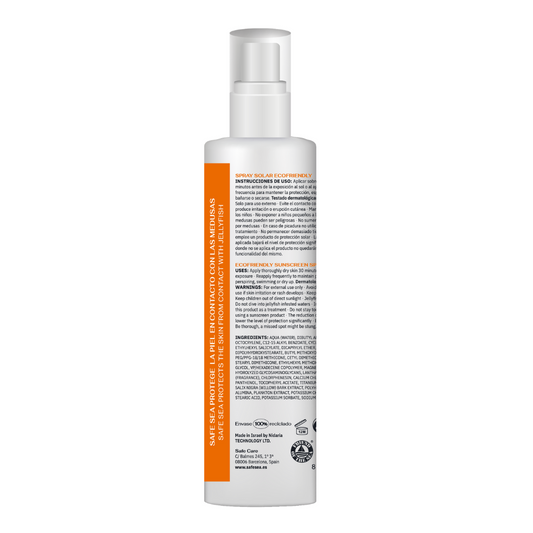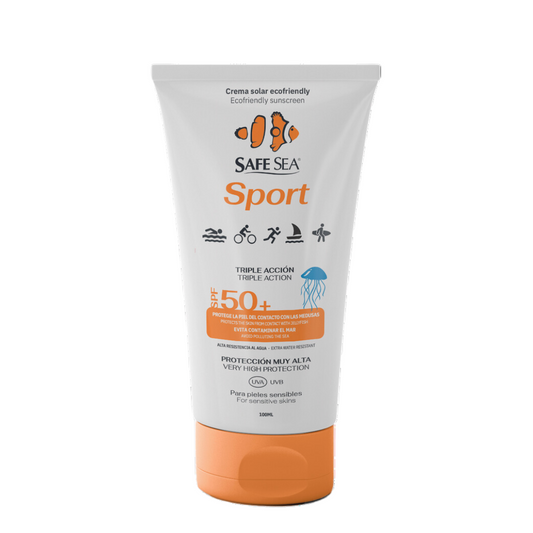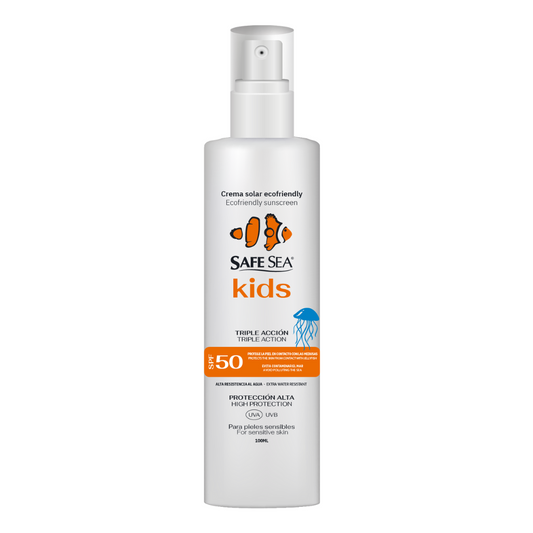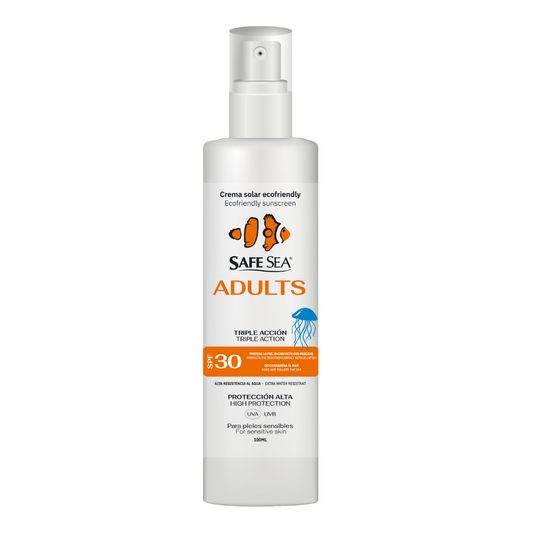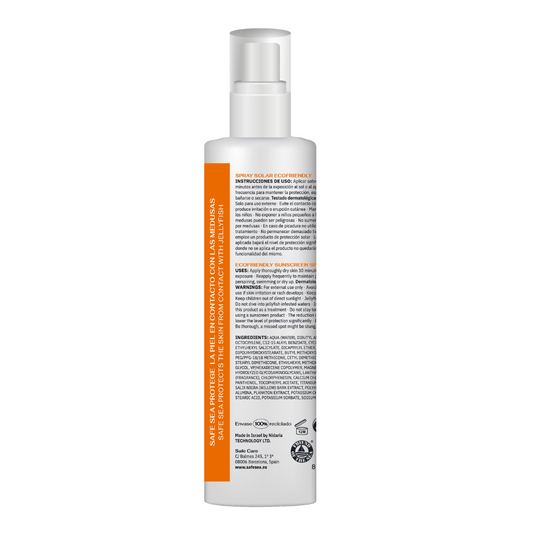
Did you know that there are more than 4,000 types of jellyfish in the world? We explain which species can be found in the Mediterranean Sea and how dangerous they are.
In recent years, the arrival of this gelatinous animal to our coasts has increased considerably. Especially in waters of the Mediterranean and the Mar Menor What is the reason for this increase in sightings? According to experts, it is mainly due to overfishing and its consequent decrease in fish populations. Pollution and the warming of the water are other factors that also favor the increasingly early and abundant appearance of these "brainless" fish.
Below, we detail the types of jellyfish that proliferate in the Spanish coasts and the consequences of their stings.
Mediterranean jellyfish species and the effects of their stings
Less dangerous types of jellyfish
Cotylorhiza tuberculata

Among the different types of Mediterranean jellyfish, we highlight for its abundance the species Cotylorhiza tuberculata. Itbelongs to the class Scyphozoa, order Rhizostomeae and family Cepheidae. It is popularly known as aguacajada, fried egg jellyfish or acalefo.
It is characterized by its peculiar morphology, in line with one of its nicknames "fried egg jellyfish". Its umbrella is flattened, yellowish brown and some greenish tones. It varies depending on the algae living inside. And with a prominent orange-brown central protrusion.
The diameter of its umbrella is 20 to 35 centimeters. It has 8 oral arms covered with appendages like small tentacles with the end in the shape of a white button.
The acalefo can be found both in open water and on the coast. They are subject to prevailing currents and winds, although it has the ability to move on its own. It is very common in the Mediterranean during summer and autumn. Especially abundant in the Mar Menor. In winter it survives as a polyp.
Is the sting of the fried egg jellyfish dangerous? Its capacity to produce urticaria is limited, so we can conclude that its danger is low. Its tentacles are short and the density of its stinging cells is low. In case of sting, its effects are very mild, not going beyond skin irritation and itching.
Rhizostoma pulmo

Of the class Scyphozpa, order Rhizostomeae and family Rhizostomatidae. It is also known as aguamala, aguaviva, blue acalefo and white jellyfish.
The diameter of its umbrella can reach up to 100 centimeters. It is characterized by a bluish-white bell-shaped umbrella, bordered with numerous violet lobes. It has 8 oral tentacles, which form a bluish-white manubrium. In its middle part it forms a kind of crown with 16 points, from the end of which protrude 8 appendages ending in mace.
The aquamala is found in both open and shallow waters. They possess the ability to actively move towards areas of greater food. It is preferably coastal, as they need to find substrate for polyps.
This species is common in the Mediterranean and the Atlantic, from late spring to autumn. It can be seen solitary or in groups.
The sting of the jellyfish Rhizostoma pulmo is of medium danger. Although it does not produce serious dermatological symptoms, the sting of Rhizodtoma pulmo can cause irritation.
Aurelia aurita
Its umbrella can measure up to 25 centimeters. Unlike other types of jellyfish, the Aurelia aurita, is characterized by not being perceived with the naked eye: both its size and its transparent color spotted with bluish white, make it difficult to see.
It can be found in lagoons and coastal areas and its abundance is scarce. Its meeting point in the Mediterranean is in the Mar Menor, but also in fjords and enclosed bays with input from inland waters.
The danger level of the Aurelia aurita jellyfish is very low. In case of a sting, the symptoms are very mild, almost negligible.
Velella velella

Class Hydromedusae, order Hydroida and family Velellidae.
Known as "sailboat jellyfish" because of its peculiar shape. It is one of the smallest and most harmless types of jellyfish in the Mediterranean. It measures between 1 and 8 centimeters. It is a modified hydrozoan with a round disc that encloses the float and contains a horny skeleton equipped with a sail, covered with a white fabric. It rises from the surface of the water to catch the wind and aid dispersal.
Unlike the rest of the specimens, they appear in swarms. They are more frequent in spring. They pose no threat to humans, since the effects of their sting are imperceptible.
Most poisonous types of jellyfish
Chysaora hysoscella

Class Scyphozoa, order Semaeostomeae and family Pelagiidae. You have probably heard of it under the name of compass jellyfish or radiate acalephus. Its size is similar to that of Aurelia aurita, with an umbrella diameter of up to 30 centimeters.
It is yellowish white in color and on its umbrella there is a very characteristic design, reminiscent of the drawing of 16 bars open to the outside. It has 24 long and thin tentacles that can measure up to 5 meters in length. In addition, it has 4 oral tentacles fused at the base, which are generally even longer than the umbrella tentacles.
This species is common in open waters, although in summer the occasional specimen can be found on the coast, dragged by sea currents. It is relatively frequent in the Mediterranean and the Atlantic.
The sting of Chysaora hysoscella is highly dangerous. It causes itching and burning at the beginning and immediately after, erythematous and edematous skin lesions appear. Even welts may appear, which may take time to disappear.
Pelagia nocticula

Class Scyphozoa, order Semacostomeae and family Pelagiidae. Popularly known as moon jellyfish. This species is characterized by its luminescent capacity. The diameter of its umbrella can measure more than 20 centimeters. So its size is similar to that of its friends Chysaora and Aurelia.
Semi-spherical umbrella, somewhat flattened and with four long and robust oral tentacles. It has 16 marginal tentacles that can reach up to 20 meters in length (the longest seen so far).
The entire surface of the umbrella, oral arms and tentacles is covered with warts (accumulations of cnidocysts).
Its reddish-pink color makes it easy to locate. It is very common in open waters, and also in the Mediterranean coast, especially during the summer.
The danger of the jellyfish Pelagia nocticula is also classified as high. It causes irritation and stinging and may leave an open wound with risk of infection. Due to its abundance and the extreme length of its tentacles, the affected area can be considerable. The effect of the venom may cause respiratory, cardiovascular and dermatological problems for weeks or even months.
Physalia physalis

Class Hydrozoa, order Siphonophora and family Physaliidae. As with the rest of the species, these names are probably not familiar to you. But the Portuguese Carabela or Physalia is. It is one of the most dangerous species, due to its morphology and toxic capacity.
Its external morphology shows a floating part (pneumatophore), formed by a float filled with gas, purplish and transparent and with a crest (similar to a sail) in its upper part that facilitates its displacements in the wind.
Its suspended part is formed by a multitude of long and thin tentacles, in charge of capturing prey and defense. They are loaded with nematocysts (stinging cells) that hang several meters below the water. As a curious fact: these tentacles can reach more than 20 meters in length.
This type of jellyfish moves at the mercy of surface currents and wind. It frequents the Atlantic, but in recent summers it has also been observed on Mediterranean coasts, in search of warm waters.
The dangerousness of the Portuguese Carabela jellyfish is very high, the highest of all types of jellyfish in the Mediterranean. So much so that contact with its tentacles can cause very serious consequences for people. It is considered the most dangerous jellyfish in the world. They contain innumerable nematocysts with neurotoxic, cytotoxic and cardiotoxic properties that can cause neurogenic shock. An intense pain takes over our body and can even cause drowning.
How to avoid jellyfish stings?
Prevention is better than cure, that is why it is necessary to know that Safe Sea sunscreens also act as anti jellyfish because they protect the skin in contact with jellyfish and prevent their sting (Tested on the following types of jellyfish: Pelagia Nocticula, Cotylorhiza Tuberculata (Fried Egg Jellyfish), Rhizostoma Pulmo, Aurelia Aurita, Chysaora Hysoscella, Physalia physalis (Portuguese Caravel), Carydbea Marsupialis (Cubomedusa)). Safe Sea sunscreens are not a jellyfish repellent, but inhibitors. The ingredients in a repellent keep the insects or animals in question away from our skin. Humans generally attract insects, ticks and other arthropods by the simple act of emanating heat and sweat. Perfumes and creams also help attract the attention of these animals.
To prevent these animals from remaining on our skin long enough to give the 'peck', the repellent forms a barrier on the surface of our dermis. This is achieved thanks to specific active ingredients, such as DEET (N,N-Diethyl-m-toluamide), a chemical compound that confuses animal receptors and interferes with their perception of environmental odors. The result is a kind of disorientation, as they do not know exactly where to bite. The duration of this protection varies according to the concentration of DEET used in the repellent formula.
The Safe Sea anti jellyfish sunscreen contains in its formula exclusive and patented ingredients, which block the sensory cells of the tentacles, just at the moment when the burning/stinging process is activated. In other words, jellyfish do come into contact with our skin, but they do not detect us as intimidation or prey.
Have you ever seen any of these types of jellyfish? And most importantly: Have you ever been stung?

